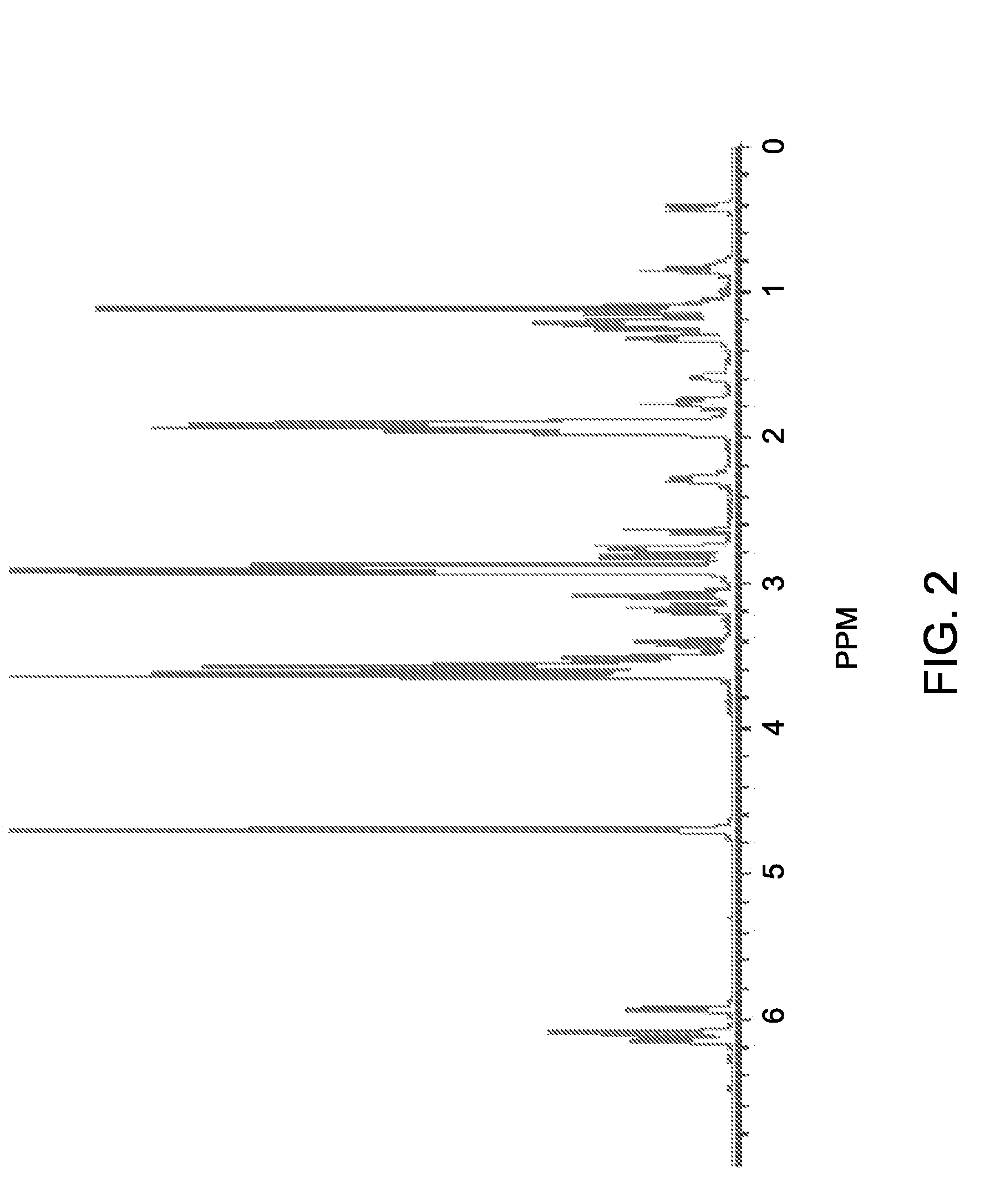Composition and Associated Method
a technology of metal complexes and catalysts, applied in the direction of catalytic reactions, group 3/13 element organic compounds, group 5/15 element organic compounds, etc., can solve the problems of metal complexes employed as metathesis catalysts that may not provide the desired catalytic activity (reaction rate, product yield, etc., to achieve the desired catalytic stability in polar solvents, and metal complexes employed as metathesis catalysts may not be soluble in polar solvents. ,
- Summary
- Abstract
- Description
- Claims
- Application Information
AI Technical Summary
Problems solved by technology
Method used
Image
Examples
example 1
Synthesis of norbornene-sodium sulfonate
[0116]5-norbornene-2-methanol (CAS 95-12-5, 1 gram) and sodium hydride (NaH, 60% dispersion in mineral oil, 0.6 grams) are dissolved in 50 milliliters of anhydrous THF. The mixture is refluxed overnight at 80 degrees C. After refluxing, 1,3-propane sultone (CAS 1120-71-4, 0.98 grams) in 20 milliliters of THF is added to the mixture in 10 minutes. After 5 hours, the solvent is removed by rotary evaporation and the reaction product is purified by column chromatography using silica and ethyl acetate / methanol (4:1) as eluent. The purified reaction product is a white solid and is soluble in water or methanol. The product yield is about 60 weight percent. FIG. 1 shows the reaction scheme and FIG. 2 shows the proton NMR spectrum of norbornene-sodium sulfonate (Sample 1).
example 2
Synthesis of norbornene-gluconate
[0117]Methanol (2 milliliters) is added to a 50 milliliters flask containing 1 gram of glucolactone (purchased from Aldrich, and used directly). Norbornenyl-methylamine (prepared by the reduction of norbornene carbonitrile with LiAlH4, 0.74 grams) is added to the flask and solid glucolactone disappears gradually within 20 minutes. The reaction is carried on overnight at room temperature. After the reaction is complete, methanol is removed by rotary evaporation. The reaction product is recrystallized from iPrOH / petroleum ether at −4 degrees Celsius. The product yield is about 70 weight percent. FIG. 3 shows the reaction scheme and FIG. 4 shows the proton NMR spectrum of norbornene gluconate (Sample 2).
example 3
Synthesis of water-soluble ruthenium complex
[0118]A ruthenium metal complex 1,3-bis(2,4,6-trimethylphenyl)-2-imidazolidinylidene)dichloro(phenylmethylene)(tricyclohexylphosphine)ruthenium (CAS No. 246047-72-3, 5 milligrams) is charged in a HPLC flask and the flask is degassed and purged with argon three times. Methylene chloride (CH2Cl2, 50 microliters) is injected into the flask using a syringe. The metal complex solution is cooled at −78 degrees Celsius in a dry ice and acetone bath. Norbornene sulfonate (10 milligrams, Sample 1 from Example 1) is charged into a second flask and degassed and the flask is backfilled with argon three times. Degassed methanol (500 microliters) is added to norbornene sulfonate using a syringe. The resulting mixture is also cooled at −78 degrees Celsius. After cooling for 5 minutes, the norbornene sulfonate mixture is transferred into the metal complex solution using a syringe. The resulting mixture is allowed to mix at −78 degrees Celsius and then the...
PUM
| Property | Measurement | Unit |
|---|---|---|
| temperature solubility | aaaaa | aaaaa |
| turnover frequency | aaaaa | aaaaa |
| time period | aaaaa | aaaaa |
Abstract
Description
Claims
Application Information
 Login to View More
Login to View More - R&D
- Intellectual Property
- Life Sciences
- Materials
- Tech Scout
- Unparalleled Data Quality
- Higher Quality Content
- 60% Fewer Hallucinations
Browse by: Latest US Patents, China's latest patents, Technical Efficacy Thesaurus, Application Domain, Technology Topic, Popular Technical Reports.
© 2025 PatSnap. All rights reserved.Legal|Privacy policy|Modern Slavery Act Transparency Statement|Sitemap|About US| Contact US: help@patsnap.com



